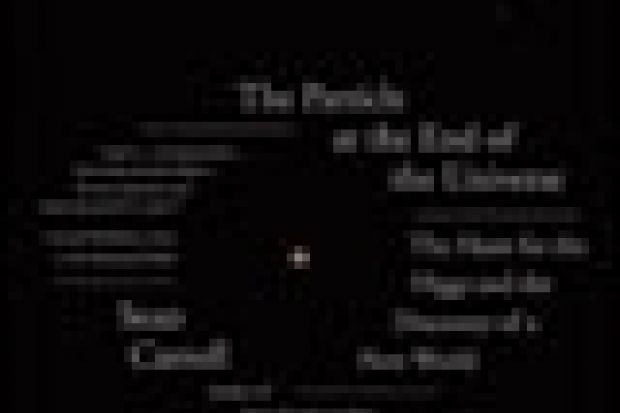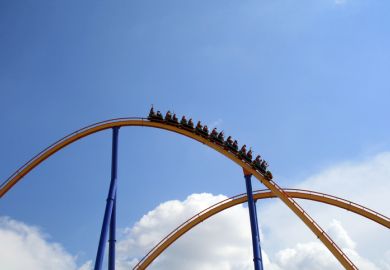An all-pervading mysterious essence is responsible for the existence of atoms and molecules. Without it, life would not exist. Focus enough energy into the vacuum and manifestations of this essence, known as Higgs bosons, can bubble momentarily into existence. Stories about the eponymous boson flooded the media during the summer, with the long-awaited news on 4 July of its probable discovery at Cern, the European Organisation for Nuclear Research. In the three months between then and the announcement of the Nobel Prize for Physics in October, a raft of books appeared.
There is a delicate balance to be struck between exploiting adrenalin-fuelled short-term excitement for anything associated with “Higgs”, and the production of lasting contributions to scholarship. A problem is that the climax of this story is yet to be writ, as the Nobel prize went elsewhere, for 2012 at least, and the primitive experimental information of July is expected to mature vastly during the next year, or even by the end of this year. With such caveats in mind, Sean Carroll’s book stands out for me from the recent competition. It is a good read, and written by a professional physicist who has taken care to explain many of the basic ideas in an accessible way.
Ask members of the public what the Higgs boson is responsible for and you are likely to be told that it is the source of mass in the universe. They have seen this in newspapers, have possibly even heard a well-known physicist say it on television or have read it in at least one of the recent books. This is, however, completely wrong, as Carroll points out.
The mass of everything hereabouts is dominantly due to the nuclei of atoms, the source of which is the kinetic energy of quarks trapped within protons and neutrons. This has nothing to do with the Higgs. As I hinted above, it is structure, rather than mass, that arises because of its mysterious presence. The Higgs is believed to give mass to fundamental particles: the size of a hydrogen atom is inversely proportional to the mass of the electron, as Carroll writes; the compactness of the nuclei of heavy atoms is due to the mass of their constituent quarks, although he does not make this point. The force that converts protons into the seeds of helium in the solar furnace, and leads to sunshine, is weak in part because its carrier - the W boson - is massive. This is critical for our existence, for had the W remained massless, like a photon, the force would have been more powerful and the Sun burned out long ago.
Carroll gives a standard entree into atoms and particles, with special consideration to the role played by experiments, which are often given short shrift in popular accounts. We learn about the history of Cern, the birth of the Large Hadron Collider and the role of the detectors. The book also gives some feeling of the quest and the people involved. While the advertised purpose of the book is the route to the Higgs, it also looks into questions of dark matter; the Opera (Oscillation Project with Emulsion-tRacking Apparatus) experiment, which initially appeared to show that neutrinos travel faster than light; and antimatter in cosmic rays. While interesting, these are not obviously mandatory for the tale of the Higgs and a novice may find the wood sometimes obscured by the trees.
One popular question focuses on how the Higgs boson itself gets mass - as though, one might say, a snake could not bite its own tail. Carroll answers this, after discussing symmetry at some length, by making the nice point that the Higgs boson has mass “because it has no reason not to”. This profound remark is at the end of an appendix and deserves to have been elevated into the main text, thereby enhancing Carroll’s discussion of symmetry and the ability of nature to hide it. The key point is that massless particles are forced to be so by some symmetry (such as gauge symmetry in the case of the photon) whereas there is no such constraint for the Higgs.
Carroll writes well and leads the reader through some deep waters. However, there are some wobbles, such as repeating the shibboleth that Peter Higgs is Scottish, even having him “return to his native Scotland” (he comes from Newcastle), and bizarrely also bestowing Mancunian Jeffrey Goldstone on the Scots. Sheldon Lee Glashow’s prediction of the Z boson is attributed to Steven Weinberg and Abdus Salam, and although Glashow is mentioned elsewhere, J.C. Ward - with whom Salam rediscovered Glashow’s ideas three years too late - is invisible.
The history of the mechanism for giving mass to the force carriers is described and the point made, correctly, that this was due to several independent scientists and thus incorrectly attributed to Higgs. Carroll mentions the early work of Philip Warren Anderson, and of Arkady Migdal and Alexander Polyakov, who have varying claims to recognition but are often overlooked. However, Higgs alone drew attention to the role of the eponymous massive boson, whose decays are crucial to proving the mechanism experimentally. This point doesn’t come across, and is potentially confused by Carroll’s suggestion that the “McDonald’s Boson” could generate significant funds from naming rights. This could be true, and is an amusing aside in a popular book, but fits less well in an ongoing serious debate about priority.
After quoting Anderson’s remark that two unwanted massless particles “seem capable” of cancelling one another, Carroll adds: “particle physicists did not get the message”. What message? To suggest that they “seem capable” is not a demonstration of how. Furthermore, Anderson considered a model without relativity, ideal for his purposes, admittedly, but not immediately applicable to particle physics, for fear of resurrecting the ether that Einstein had done away with decades earlier. Making a relativistic version of the ether, which is in effect what Higgs and five others achieved independently in 1964, is what those in the trade call “non-trivial”. This subtlety is rather lost in the narrative.
Then there is the ongoing debate about how credits should be shared among the sextet: Higgs scooped the team of Gerald Guralnik, C. Richard Hagen and Tom Kibble by a matter of weeks, himself having been beaten to the mass mechanism by Robert Brout and Francois Englert. Higgs was unaware of Brout and Englert, with the manuscript of his second paper, containing the massive boson, coincidentally being received by the editor of Physical Review Letters on the same day that their paper was published.
So much for the mass mechanism; what about the massive boson that carries Higgs’ name? Guralnik et al. have a boson but without mass, while Brout and Englert have no boson at all. Carroll surprisingly asserts that for Brout and Englert the boson is “implicit in their equations”, and that for Guralnik et al. “we expect the Higgs to be massive”. Physicists may draw their own conclusions as to how “implicit” the boson is, and it is not clear whom the “we” refers to in the latter reference, as I find no such remark in the trio’s paper. Three years later, Kibble alone developed these ideas to show how the photon can remain massless while the W boson gains a mass. In so doing, he made contact with reality as now established, an important contribution that isn’t highlighted in the narrative.
If you want to know why the Higgs boson has excited so much interest, this book is an excellent place to start. However, if you are a historian or a member of the Nobel prize committee, tread carefully.
The Author
Sean Carroll, senior research associate in the department of physics at the California Institute of Technology, calls Caltech “an absolutely unique place. For the right kind of student, it’s the best place in the world but it’s certainly not for everyone. It is undoubtedly a fantastic place to be a scientific researcher, that’s for sure.”
Born in Philadelphia, Carroll “grew up in a small suburb…Eventually I discovered that I much prefer living in big cities, and have tried to stick to those ever since. Now I live in Los Angeles, and I am married to Jennifer Ouellette, an accomplished science writer.
“Most of my initial interest in science didn’t come from people but from books,” he recalls. “When I was young (maybe 10 years old) I would read every book about relativity and particle physics I could get my hands on. I’m not sure what exactly first ignited the interest but once it took hold I was hooked for life.”
Author of several acclaimed science books, Carroll believes “any scientist can improve at communication - even ones who already enjoy it and are good at it. Like anything, practice and effort will make you better. The best tip is to try as hard as you can to put yourself into the mindset of someone who knows nothing about your subject and try to capture something of what makes you so passionate about it. And, of course, actually try to communicate with non-experts and figure out whether you’re able to make sense to them.”
In his spare time, Carroll is “an avid poker player - good enough to get by and break even but I’m not raking in a lot of money, that’s for sure. I’d love to be a musician, but I just don’t have it in me. As I write, there is a bass guitar sitting directly behind me, forlorn at its lack of use.”
The Particle at the End of the Universe: The Hunt for the Higgs and the Discovery of a New World
By Sean Carroll
Oneworld, 336pp, £16.99
ISBN 9781780742328
Published 15 November 2012
Register to continue
Why register?
- Registration is free and only takes a moment
- Once registered, you can read 3 articles a month
- Sign up for our newsletter
Subscribe
Or subscribe for unlimited access to:
- Unlimited access to news, views, insights & reviews
- Digital editions
- Digital access to THE’s university and college rankings analysis
Already registered or a current subscriber? Login




